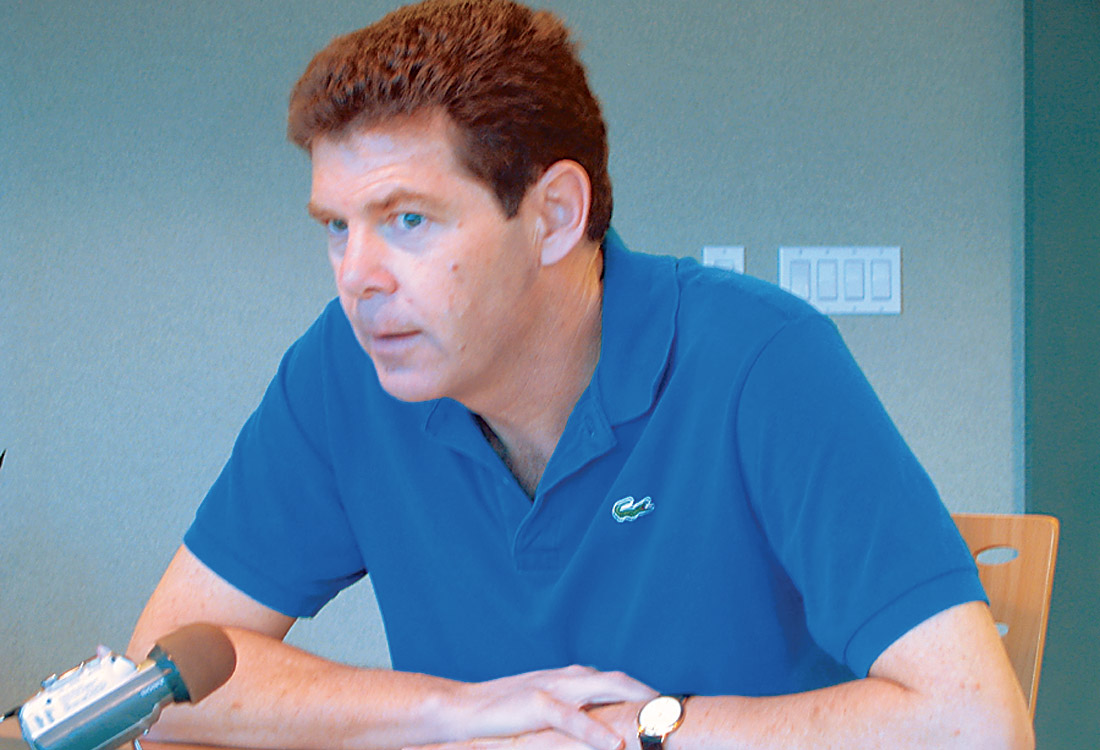
A long time CSEG member and supporter, Dave Paterson recently returned to live and work in Calgary. The RECORDER editors jumped at the chance to interview Dave, as he can share a unique perspective with the readership, that being a CSEG member who has worked most of his career in the international arena. In addition to that, Dave played a key role in the establishment of the RECORDER as a proper monthly magazine. His interesting and insightful comments on these and other topics are contained in the following interview.
[Satinder]: So let me begin by asking you about your educational background and work experience.
I was born in Vancouver and lived there right through to graduation from UBC in 1975 with a B.Sc. in Geology & Geophysics. There was though, a 2 year gap in the middle of university when I went backpacking around the world.
[Oliver]: And you did some summer fieldwork.
That’s right – during summer breaks at university I worked in mineral exploration - undergrads were a source of cheap labor for the mining companies, and it provided the students with some geology exposure. A win-win situation! We would work every day for four months hiking up and down mountain streams collecting soil samples. The work was all based from helicopter-supported fly camps. You could save enough money over the season to pay for the next year’s living and tuition fees. My field area was in the Omenica, north of Fort Saint James. I also worked in logging camps during the summers prior to studying geophysics.
[Oliver]: Was the combination of geology and geophysics unusual?
Well, I was a typical kid in my own way. We had heard of geophysics, but nobody coming out of high school usually has aspirations to study in that field. I was actually much more interested in history, archaeology and anthropology. But, because these subjects were in the Arts Faculty, foreign language courses were also required to get a degree. I just didn’t have the French language ability for university level studies. So, I chose a basic science program in first year hoping something would catch my interest, but I was leaning towards chemistry.
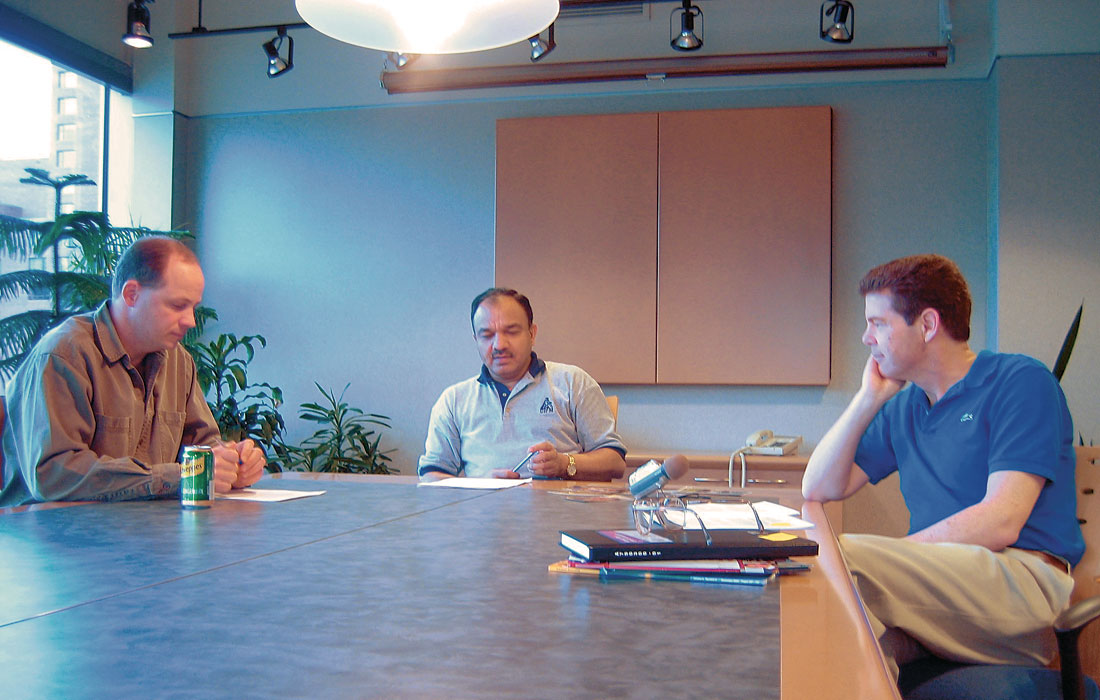
I was sitting in a logging camp filling out my entrance requirements for university and I couldn’t slot the art prerequisites into my class schedules and the only program that fitted was geology. The geology course was interesting and the professor, Dr. Danner, took the time to personally encourage me to study geology further. The personal touch was appreciated because UBC was a big university, 30,000 people, 25,000 undergrads; first year classes, even the highest level classes like chemistry, had five, six hundred people in a lecture theatre. Then prior to second year I was making my course selections and I said, “Well I still don’t know what I want to do, but why not combine geology and physics?” And that’s how I got into geology and geophysics. It was a fluke – just like everyone else I know in the industry.
[Oliver]: And after graduation, did you enter the industry right away?
Yes, I went through the interviews but mining was just dying at that time, in ’75. Being on the West Coast, I had no exposure to oil and gas but I went to the interviews with the idea that I’d just try it, and if it worked out, fine. I interviewed with a number of companies and Jack Pullen was Chief Geophysicist at HBOG. It was an interesting interview because we talked mostly about skiing – I think he wanted to make sure I would adapt to Calgary.
[Oliver]: Hasn’t Jack just retired?
Yes, about a year ago, I think. He was President of CSEG the first year I came into the industry. A lot of CSEG executive committee members and volunteers came from HBOG.
[Satinder]: Neil Rutherford, whom we just interviewed, was at HBOG too, wasn’t he?
He was my supervisor in my first year. At HBOG, for a two-year period you’d do different positions with the company’s Vibroseis field crew. So, I remember by my second week of work I was out in the field west of Bragg Creek planting geophones. You weren’t treated any differently because you were from the office. It was a good way to break into the industry – learning geophysics from the ground up.
[Satinder]: In 1982, this HBOG was bought by Dome. Did you work for Dome for so many years?
When the takeover occurred, I was based in Calgary with the international group of Hudson’s Bay doing new venture work in South America. Dome, as you’re aware, was in financial trouble right away as interest rates were at about 18% , and they had to start selling assets. So, we were pretty well left intact and we spent a year selling ourselves as an international group. A small British company, LASMO, bought us as their starter kit to break into international exploration outside of their North Sea production base. Hudbay at that time had offices in Perth and Jakarta and operations in many other countries. LASMO took the whole operation lock, stock and barrel and most of the guys overseas just moved across to the new company. Also, seven of us based in Calgary moved to London.
[Satinder]: And you worked for LASMO for about five years?
No, I was with LASMO for 18 years and I never really quit HBOG/Dome. I just went along with the assets I was working on. So, it was 25 years in total. I got out in 2001 when ENI bought LASMO, as going to work for a large organization like that had no attraction for me.
[Satinder]: What did you do after LASMO?
At the time of the takeover, I was based in London and we wanted to remain there because of where the kids were in school. There were few employment opportunities in London because all of the North Sea work had moved to Aberdeen and a lot of international work was going to Houston. I worked with Hydrosearch as an associate consultant on international interpretation projects for a couple of years. Then it was the right time for the family to move back here after twelve years away. I’ve been back since November. I got lucky and picked up work right away with First Calgary doing regional geology studies in Algeria. I’m just doing project work, no operations, and it will run another month or two.
[Oliver]: You must have had a lot of experiences; could you tell us about some of them?
I had good training and project experience with HBOG for my first 7 years. I worked Western Canada, East Coast Canada, and International. With LASMO I had a couple of years in London working international back in the early ’80s and then came back to Calgary when the company started a Western Canada operation. I had five years in Western Canada as Geophysical Manager, as the operation grew fro m start-up to 5,000 barrels a day. In 1989, LASMO was developing the Cohasset and Panuke fields off shore Nova Scotia. I was the third employee and that was really exciting being involved in Canada’s first commercial offshore operation.
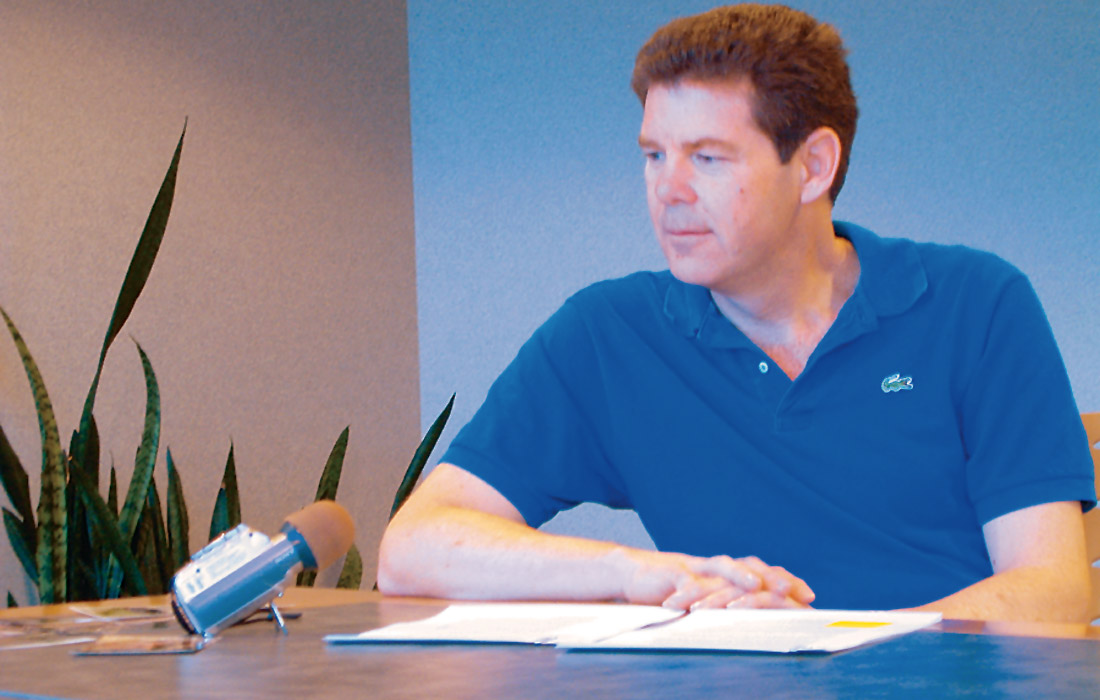
[Oliver]: Was that out of Halifax?
The company was based in Halifax but I stayed in Calgary with the geoscience group right up until first production, because we were processing our 2-D and 3-D seismic in Calgary, and there was no interpretation systems support in Halifax. We had a five-man group here in Calgary. I was Exploration Manager and I hired geologists and geophysicists to support the development team. The project was really exciting because besides the technical challenges there was this Maritime Mission behind everything we did. I think there were only about two of us that were non-Maritimers and after all the false dawns over the years this time a project was actually going to get commissioned. It was probably the most focused, tightly-knit group, and the most fun project, with which I’ve ever been involved. The fields were small but the first well came in at about 30,000 barrels a day.
We only had six months living in Halifax and then moved on to Indonesia , where we spent five years. I was involved in two different operations. First I was seconded into a company called VICO. They produced 1.7 BCFD for LNG export. At the time, it was one of the largest LNG operations in the world. After the initial exploration success 20 years previously, 17 straight dry holes had been drilled and budgets were in place for a further 50 to 100 million dollar exploration programme. I was brought in to lead the in-house technical team in a regional basin study to determine if further exploration was justified. I was on that project for three-and-a-half years.
[Satinder]: That was in Balikpapan on Borneo?
Yes, that was the operational base, but the geoscience team was in Jakarta. We would go back and forth for our field studies and drilling, but most of the staff was in Jakarta, about thirty people. It was a fascinating opportunity to be advancing the understanding of the geology of Indonesia’s second largest petroleum basin. Our study gave a boost to VICO’s exploitation efforts and we published a lot of papers in the local journals. However we concluded that most of the remaining exploration potential was offshore and especially in the deepwater. LASMO later farmed-in to Unocal’s Kutai basin deepwater licenses and the partnership has discovered several TCF to date.
[Oliver]: While we’re in the Kutai Basin, you mentioned that you had a little overlap with Bre-X while working there?
Yes, and that was kind of interesting. By that time I had moved from VICO to LASMO’s independent exploration operation on acreage that was contiguous to the VICO license on Borneo. It included the whole onshore portion of the basin. Bre-X were based in Samarinda where we also had our operations base. When they started having some “success”, the international gold companies started visiting our offices to discuss the geology because we had the best regional database from 5 years of exploration. We couldn’t understand Bre-X’s geology model from the little they did p resent. A clue to the deception was on the vintage seismic lines over their block that tied an old exploration well. Our interpretation indicated their property was located on a basin inversion structure and we speculated that perhaps there was mineralization associated with the faulting. We were drilling milder inversion structures further north in the basin, ending-up with a gas discovery.
The Suharto family was forcing their way into the gold operation and they were caught holding the bag when it collapsed; it was really humiliating to them and to Indonesia. It tarnished Canada’s reputation and any comments about local business practices would be thrown back at you as a Canadian. Transfer of best business practices is really the role of the expat in foreign operations. Technology transfer is often the stated role but that is secondary. And you need that credibility with your staff, the service sector, and the government in order to contribute.
[Satinder]: How do you find the culture of consultancy different fro m that of being a regular employee in a company?
Well, it’s interesting after 25 years as a salaried employee to go into the service sector. You become a lot more focused in matching what you want out of your profession with what is required in the market place. Initially, I thought a lot of the consulting work would be specialist, such as AVO studies. However, in writing the tenders for the consultancy in London, I found the international market required generalist seismic data interpreters. In general, there are two pre requisites: workstation capability and previous work experience in a similar geological setting, deepwater salt structures for example. We would put forward candidates who were ex-managers and very capable people, but they’d be turned down for more junior people, because the younger people would not need as much time to become proficient on the workstations. The experience factor was really discounted a lot.
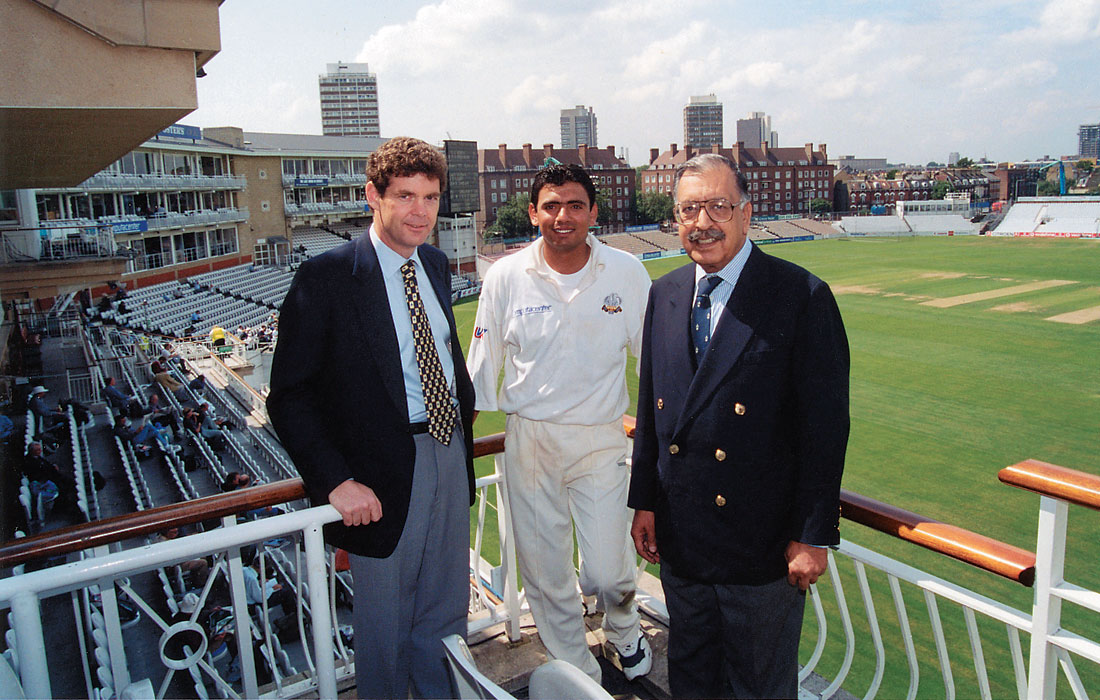
I had the same hurdles to cross, as I had not interpreted on a workstation for 10 years. I find that you win the commission on basic capabilities, but you’re subsequently able to contribute so much more to the project because of the experience factor. Places I’ve worked as a consultant include Malaysia, Dubai, and Egypt. In these overseas contracts you’re expected to hit the ground running. Usually you’re hired because the client is short of people. Everyone is busy and there is minimal IT and technician support. All this requires independence and resourcefulness from the consultant. You are much more aware of the clock because consultant fees are allocated directly to a project and any slippage becomes much more obvious than with in-house staff costs. The aim is to provide the interpretation and mapping scoped and leave unexplored those secondary technical aspects you would pursue if you were on staff.
[Satinder]: You’ve been around the world. Did you like doing what you did in different countries?
I enjoyed it and I actually think it’s a pre requisite to be interested in travel and foreign cultures. I think if you go just for the technical challenge of work or just for the money, it will not be a successful experience. There’s a lot of stress involved for you and for your family. It’s like starting over each time you move. I think the people who can pursue their non-professional interests in the new posting usually adapt very well. For me, it was learning the local language and history, whilst continuing to keep a balance between work and recreation time.
[Oliver]: Are you hoping to continue with the International sector as a consultant?
Yes, that is my initial plan in coming back to Calgary. What strikes me about Calgary is that it must be the most professionally attractive place in the world to work as a geoscientist, as it is such a concentrated and accessible community – attractive both technically and for business. In London there were technical lectures once a month, but to attend them was a five hour commitment out of my day. Only forty to fifty people out of the community of two thousand would actually attend a lecture. In three months here, I have probably had more contact with other professionals than I had in three years in Indonesia or in London. The other thing is that everybody seems to be an entre preneurhere; they’ve got their eye on the business angle and future opportunities. I enjoy working as a consultant but there’s all these other opportunities available here as well; we’ll see how it works out.
[Satinder]: You have been in the geology business for a long time. Have you in the course of 25-30 years been assimilating new technology?
I’ve stayed abreast of the technology and science through the journals and conventions. There has been a huge increase in the number of papers that come out in a year and the internet has made them so accessible. For example, I was working in Dubai and was able to download several structure papers relevant to a Caspian Sea structural project. As a consultant this service from the societies is very valuable. I follow several technical areas of research in the literature. For example, overpressure was a major interpretation problem on the Indonesian projects I worked-on, and so, I have made a point of keeping up to speed on the latest ideas. Other are a s would include coal source rocks, seismic stratigraphy, delta stratigraphy, and inversion structures. On the commercial side, risk analysis, portfolio management, and geostatistical techniques are developing fast and need to be followed.
[Satinder]: Let’s talk about the RECORDER – did you develop it on your own?
Brian Link was RECORDER Editor in ’85, I think, and at that time it was just a basic newsletter with announcements about society activities. I took over from Brian and discovered subsequently that an objective of the CSEG executive was to expand the content and move to a magazine format. The Leading Edge and the Denver Society’s The Record were examples. Increased costs meant we had to get some advertising and the increased format meant it was more than a one man job. We formed a committee. Barry Johnson did the advertising, Trev Hammill was photo editor and John Varsek and Keith Young were feature editors. It was all in the non-digital age, a cut and paste job and a lot of work Articles always seemed to come in just in time, though it was always a struggle. Our biggest concern was the advertising, but the service industry actually was magnificent and offered the support needed. In fact, we had to actually restrict the amount of advertising because we could never get the content volume up.
[Oliver]: And have you maintained your CSEG membership over the years when you were abroad?
Yes, just to see who was moving where and what was happening.
[Satinder]: So what do you feel now on the quality of RECORDER as compared to other magazines that you could get?
The improvements in content over the last two years or three years are the most significant since the initial change to magazine format 20 years ago. I find the articles very topical. For example, I circulated the seismic imaging and data processing articles amongst the seismic processing consultants I shared an office with in London with great interest. I have these binders where I file reference papers and articles by subject. Previously, there was nothing coming out of the RECORDER, but now I have a number of articles filed.
[Satinder]: Do you have any suggestions for improving the RECORDER?
It is interesting to compare the approaches of the different technical societies to publications. The PESGB for example is mostly newsletter. Seapex and IPA are also more newsletter than technical, but these societies also publish full proceeding of the papers published at their conventions. I find the RECORDER articles up-to-date, as those in The Leading Edge, and useful for the guy that’s working on processing or interpretation problems every day. But, I also like the case studies to read as well. I think for geophysical interpreters the best publications are a combination of geological case histories such as the CSPG Bulletin and technology applications, best presented in magazine format like RECORDER.
[Satinder]: So we are providing good value then?
I have seen the RECORDER everywhere I have traveled. Typically one person who might have worked in Canada in the past will subscribe and pass it around. So what do you publish, 1,500 or 2,000 a month?
[Satinder]: Twenty-three hundred.
Twenty-three hundred? So you multiply that as it gets passed around and readership is much higher still.
[Satinder]: It is all about membership service.
Yeah, and I think that’s the way it’s got to go. For example, the lunch hour talks CSPG started recording and putting on their internet site are great. I suggested the PESGB try this in the UK as they have several thousand members, but so few are able to attend the talks.
[Satinder]: I think the problem is the sponsorship of the services, to find money to get that done is difficult.
It’s a valid point. You could ask, where is the real value to your membership of the various services? If a lot of your membership are now consultants or with small firms and they look to the Society to keep abreast on the technical issues, then you need to address that. It is all moving very fast towards going online for papers.
[Satinder]: As with anything, you need to find the right balance between cost and benefit.
Well of course, it’s self-interest to the consultant if he has access to a paper. I think it’s tremendous. The IPA and Seapex, when they put on a convention, they actually publish the paper so it’s not just an abstract, it’s a real paper. So they don’t put so much in a newsletter but once a year, you get this tremendous volume of technical material coming out. So the emphasis is a little bit different depending which society you’re in.
[Oliver]: Earlier on you mentioned your love of history, archaeology and culture. What are some of the favorite spots you worked in?
I like Asia, Southeast Asia. I studied the history of that area in university. I first traveled there about thirty years ago and it’s changing so fast. Places like Europe are changing, but not as fast.
[Oliver]: Regarding your family, have they enjoyed moving back to Calgary or is it kind of foreign to them now?
Everyone has adapted quite well to the move. My youngest is 15 and was 3 when we left and doesn’t remember anything. The kids were in schools overseas with an American curriculum, so the teenage culture is the same. A few Canadian cultural traditions will have to be learned, such as hockey. There are issues with families moving, especially when the kids get older. It’s one reason why we came back as my oldest was off to university this year and the youngest is going into high school.
[Oliver]: I traveled a lot and lived overseas when I was a kid, me and my three siblings. It was great, but I have developed the opinion that once kids get into adolescence, it’s really important to have stability – peer group stability.
We had the most trouble with a move when my oldest was 12 and we moved from Indonesia to Europe. There are pluses and minuses with family. I think it works very, very well with young families.
[Oliver]: Who were some of your mentors when you were in Canada?
You know, I was thinking about that before this interview. My recollection is that the younger geophysicists in the company educated each other about the business and the emerging technology, especially seismic data processing techniques such as deconvolution and migration theory. The set-up at Hudson’s Bay, with all geophysicists in their first 2 years attached to the company seismic crew, made learning fro m your peers a natural forum. Many of the more experienced geophysicists were already into management, and the interpreters in their 40s, 50s and 60s – yes, they existed in those days – had been left behind in the switch from analogue to digital.
[Oliver]: So there was kind of a technical gap then?
There was. There was this opportunity for the guys who were just out of university to apply their math and physics theory. The responsibilities we were given early in our careers with the company seismic crew also gave us confidence and independence as a group. My peer group included Neil Rutherford, Fred Baker, Larry Mewhort, Gary Bilous, Gary Focht, Norm Kalmanovitch, and Murray Olson. These guys have all gone on to successful professional careers and filled many CSEG volunteer positions over the years. An example of the level of technical work was Gary and Fred’s recognition and successful application of the first bright spot analysis in Alberta on the Colony sand play. I got involved the next year as seismic party chief with the world’s second shear wave group shoot – as an Alberta consortium shot a number of test lines.
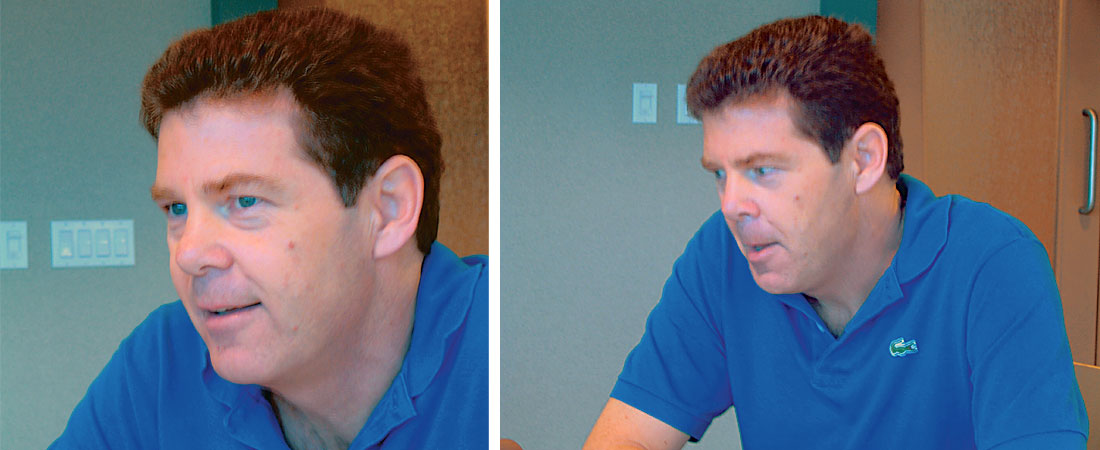
If I learned my geophysics from my Hudson Bay peers, I learned my geology and the international side of the business from more senior colleagues at Hudbay. These would include Dave Powell, who has just retired as Chairman of Talisman, and Steve Mills, who was a VP at Can Oxy at one time. Dick Lee, a geologist with a North Sea background, showed me how to scale-up from Western Canada prospecting to basin scale geology. In international the seismic data becomes the framework for all of the basin studies as there is usually a scarcity of well control, and thus the geophysicist is required to provide more of the geology analysis.
Learning how to contribute technically as a non-operator in an international setting is hard when you only see the operating staff twice a year. In Calgary’s business climate you are used to dealing with many different companies on a variety of projects – trust and informality is the norm. This experience is useful internationally and I have found Canadians able to contribute to partnerships where companies fro m other countries are locked-in to more formal, confrontational styles. The ERCB is an excellent example of how an open access database benefits everyone.
[Oliver]: Well I believe many countries have used Alberta as a model when setting up the legal and regulatory framework for their own oil and gas industries, including ERCB-style databases.
Even places like the UK didn’t do that, and they are running hard now to attract investment from small companies that need the access to that kind of database
[Oliver]: Typically, what skills do you have to enter the international consultant market?
There’s much more breadth to the technical expertise and experience required than just working Western Canada alone can provide. The best analogy technically would probably be like a Foothills project or an East Coast Canada project. Thus, to consider being a consultant you have to first acquire international experience with a company and this opportunity is changing, like everything else. You used to work for a service company as a data processor or for an oil company. You could then transfer out to a subsidiary of a company, and that was always a nice way to do it because basically they took care of you. You were a few years in one posting and then if everything worked out well, you’d get another opportunity and eventually you’d have this opportunity to go back to your base.
But those opportunities are really shrinking now. The majors are pulling out of many countries and the intermediates are not investing. I still think the best route to international work is to stay with one organization. I think it’s difficult to go out and take some of the opportunities that are in the Gulf and North Africa because you do your two or three years, then what do you do, because it doesn’t move you automatically to another company. What you can do to prepare is first express an interest and then try to get the kind of technical background that would be of interest to somebody. Really your aptitude and attitude are 70 percent of it. But generally Canadians, and there are thousands of them overseas, have done very well.
[Satinder]: Thank you very much for talking to us.
You’re very welcome – it’s been a pleasure!











Share This Interview